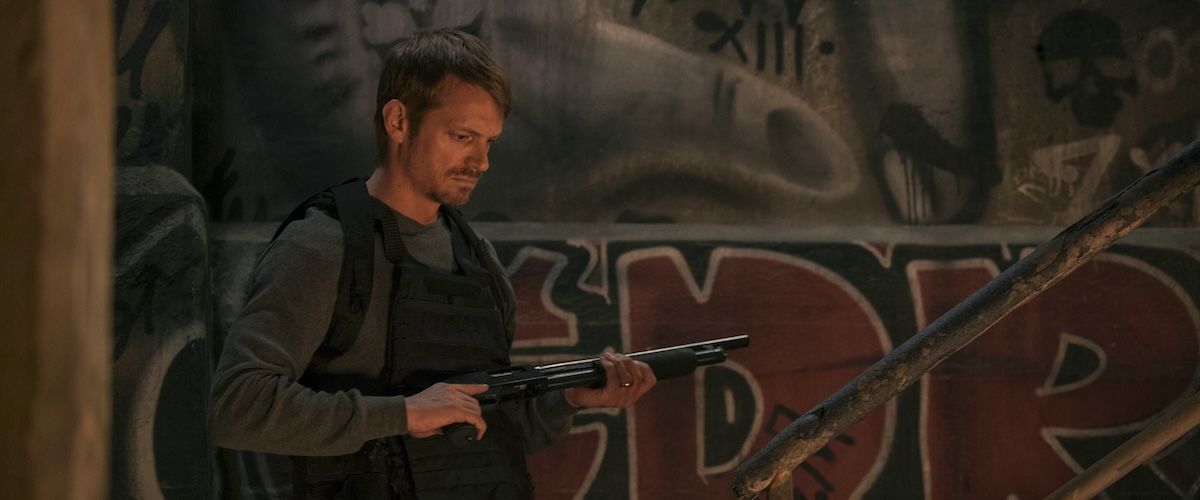Jonah Naplan December 20, 2023
Language is key in a motion picture. But “Silent Night” proves that it doesn’t have to come in the form of dialogue. The film, which is the legendary John Woo’s first English-language picture in twenty years, has no speaking characters; the only verbal communication comes through radio broadcasts, news reports, or, occasionally, grunts and groans of pain. This is an exceptionally violent revenge thriller, filled with all of the Woo-isms and tropes you’d expect, but it also may catch you off-guard with a few sneaky surprises along the way. The plotting itself is nothing new, but it’s told in a smart dialect, and there’s probably about ten crucial moments in the film when you think the lack of dialogue won’t work, and then it does. But by then you won’t even realize it because of how much you’ve been riveted by the story and characters.
The film is about a grieving father named Brian Godlock (Joel Kinnaman), who sets out on a bloody revenge spree after an unimaginable series of events redefines his life. A brutal shootout between two warring gangs in his neighborhood not only renders him unable to speak when he gets shot in the throat, but a stray bullet murders his young son. The tragedy tears his marriage with Saya (Catalina Sandino Moreno) apart, and he’s left stranded with his own grief. The man concocts a plan: on Christmas Eve of the following year, he will get his revenge on the gang that upended his life forever, marking the date on his calender with “KILL THEM ALL.” So he spends the next months training, hardening his physique and body, learning to become a killing machine. He drives circles around and around a truck depot, lifts weights, practices his moves on a dummy, watches instructional videos, shoots at a gun range, and contemplates his morals.
The only problem is that there ends up being far more preparation for the action than the action itself, the latter being the reason we actually came to the movie. It’s a real shame too, because when the action does happen, it is utterly magisterial and gorgeous in all its gory glamor. John Woo has a brilliant eye for intrinsic details in his fight sequences, all of which seem to draw upon the great work of Sergio Leone and Jackie Chan, fellow masters of the form who demonstrated not only the importance of being invested in a brawl, but attached to the characters who are brawling. “Silent Night” is at its weakest when it moves away from those scenes, diving into slow moments that don’t have nearly the same precise pacing or intrigue.
Yes, you’ve seen this movie many times before. We get one of these revenge thrillers at least once every single year, each with varying levels of quality, and they include not only similar plots but similar characters; the villains are a gang of vicious Latinos led by the tattooed Playa (Harold Torres), who is not afforded any real character depth other than he’s bad for whatever reason the average gang leader is bad. That’s about it. And the one police officer who’s on the case is Detective Vassell (popular rapper Kid Cudi), a morally upstanding Black man, who comes to Brian’s aid just in the nick of time, despite his earlier claims that he wouldn’t need any help.
“Silent Night” draws upon classics such as “Die Hard” and even modern-day totems like the “John Wick” franchise and “The Batman,” the latter of which poses the best examples of how subtle dark humor can be incorporated into an otherwise serious film. The best depiction of this in “Silent Night” comes at the beginning, as Brian, bloodied and battered, runs through the streets wearing a Rudolph sweater; the little bell on the reindeer’s nose jingling as he sprints. I wished for more perfect moments like this; tiny things that won’t stick with you unless you suspend your disbelief in the narrative and surrender to the exercise.
The film was written by Robert Archer Lynn, and I wonder what his screenplay looks like on paper, granted that it’s one without any dialogue. Woo has long explored moments of “pure cinema,” prolonged sequences that are bare in volume, but meaty in expression and action; they are choreographed dance numbers as much as they are fight scenes. By making “Silent Night” one long version of this, Woo challenges himself to keep the physicality intriguing enough so that we’re never bored, longing for a story that does not wallow in grunts or gasps to convey emotion. For a little while, you’re distracted by spotting if the film really does live up to its promise, keeping your ears open for any small peep from an on-screen character, but eventually, you get so wrapped up in the story that you forget to notice. Occasionally, there’s a very obvious moment in which it would have made a lot more sense to have a scene unfold with dialogue, and the filmmakers are clearly limited by their refrainment from doing so. And yet there are many moments in the film that I was surprised had as large of an emotional kick as they did, even without the benefit of verbal speech. After all, the old saying still rings true: actions speak louder than words.
“Silent Night” slowly loses its Christmas spirit as it skips along, forgetting that it has a holiday backdrop, but regardless, it works just as well as an action film that can be watched at any point during the year. Kinnaman, who saw a spike in fame because of two “Suicide Squad” movies, looks to have a bright future ahead of him and this picture helps to solidify that success. Like the stars of actual silent movies, he’s channeling a talent most Hollywood actors could use a lot more of right now: purity of emotion.
Now playing in theaters.

